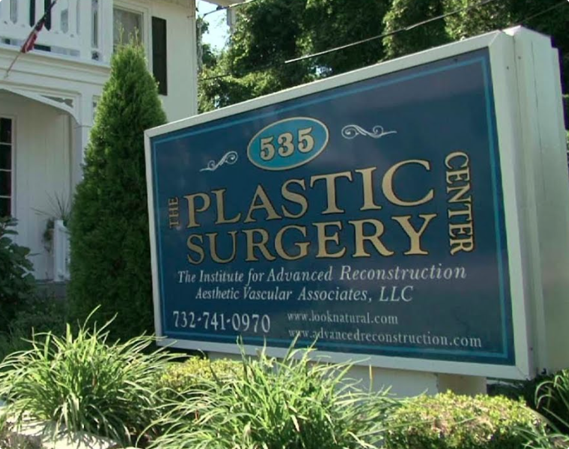Prophylactic Mastectomy & Reconstruction After BRCA Testing
Advances in genetic testing have made it possible for people to learn the risk factors for many conditions, including breast cancer. Women who test positive for the BRCA1 or BRCA2 genetic mutations are at higher risk of developing breast cancer in their lifetime. As a preventative measure, many women elect to undergo a prophylactic (risk-reducing) mastectomy for one or both breasts, followed by breast reconstruction surgery.
For More Information or to Request An Appointment
Call 855-980-6981 or Click Here
What Are BRCA1 and BRCA2?
BRCA1 (breast cancer 1) and BRCA2 (breast cancer 2) are tumor-suppressing genes. In healthy, normal cells, BRCA1 and BRCA2 help protect you from getting certain cancers. However, mutations in the BRCA1 and BRCA2 genes interfere with them working properly, elevating an individual’s risk for breast cancer and more.
Inherited mutations of BRCA1 and BRCA2 account for roughly 3% of breast cancers (about 7,500 women per year). However, having a BRCA1 or BRCA2 mutation does not automatically mean you will get breast cancer.
What Is the Difference Between BRCA1 and BRCA2?
Women who inherit a harmful variant of either BRCA 1 or BRCA2 are at a higher risk of developing cancer in their lifetimes, compared to the risk for the general population, which is 12%. Though mutations can occur with both BRCA1 and BRCA2 genes, there are a few key differences.
BRCA1
- More common
- Comparatively higher risk when mutation occurs
- 55-72% chance of developing breast cancer by age 70
BRCA2
- Less common
- Comparatively lower risk when mutation occurs
- 45-69% chance of developing breast cancer by age 70
Is Prophylactic Mastectomy Right for Me?
Testing positive for mutations in BRCA1 or BRCA2 can feel overwhelming. You may struggle with your decision about how to move forward. It’s important to remember that a positive test result does not automatically mean you will develop cancer. However, understanding ways to reduce your risk can alleviate some of your anxiety. One way to lower your chances of developing breast cancer is to undergo a prophylactic mastectomy.
A prophylactic mastectomy involves removing as much of the at-risk tissue as possible. Considering this, many women choose to remove both breasts. This surgery has been shown to reduce the risk of developing breast cancer by 95% in women who have a disease-causing mutation of BRCA1 or BRCA2.
Though this risk-reducing surgery is highly effective, it does not guarantee protection against breast cancer. For this reason, it is important to note that breast reconstruction will not interfere with future breast cancer treatment or screening if needed.
While prophylactic mastectomy cannot completely prevent future breast cancer, it is still a powerful measure women can take to protect themselves.
What Are My Options for Breast Reconstruction After Mastectomy?
With our breast reconstruction procedures, we aim to restore a natural appearance that allows patients to feel comfortable in their skin. Our highly qualified surgeons recreate a woman’s breast using implants, the body’s own tissue, or a combination of the two. Which procedure we use will depend on many factors, including your anatomy, your preferences, and other aspects of your individual case. We offer several options, and your surgeon will discuss each one with you in-depth during your consultation to help you make an informed decision.

Autologous Breast Reconstruction
Autologous breast reconstruction uses tissue from a patient’s own body to recreate the breast. This technique takes skin, fat and sometimes muscle from another place on the body—the stomach, upper back, buttocks or inner thigh—and reattaches the flap or tissue at the site of the mastectomy. We perform several different types of autologous breast reconstruction using pedicled flaps (blood supply to the flap remains attached) or free flaps (blood supply to the flap is separated and reattached).

Implant-Based Reconstruction
Implant-based breast reconstruction, which uses silicone or saline implants to recreate the breast, is a desirable choice for many women. We typically perform this type of reconstruction in two stages, requiring a temporary tissue expander to first be placed in the breast pocket and then filled with either saline or air to stretch the muscle and skin to the desired volume. Once this happens, we replace the saline or air with a breast implant.

Combined Autologous and Implant Reconstruction
A combined autologous and implant-based reconstruction can be a good option for patients who do not have enough tissue to create a natural breast shape from a flap reconstruction alone. This hybrid procedure may also be preferred by some women as it helps minimize the appearance of the implant through the skin. We most commonly use implants in combination with DIEP flaps and latissimus dorsi flaps.

Nipple-Sparing Mastectomy Reconstruction
When possible, our surgeons aim to spare the nipple and areola when performing mastectomies. Women who elect to have a total prophylactic mastectomy due to a positive BRCA1 or BRCA2 gene may be good candidates for such procedures. We will discuss possibilities for your specific case during your consultation.
Our mission is to improve the quality of our patients’ lives
Our cutting-edge procedures have helped transform the lives of our patients. Hear all about it from them
Consultation for BRCA:
As active members of the breast cancer community, our surgical team is well-versed in a wide array of reconstruction procedures. Our patient-first approach means we serve as your advocates, guiding you in your decision and ensuring that you are pleased with your results. We understand that considering a prophylactic mastectomy can be very emotional. Our breast surgeons and genetic counselors are here to provide you with the information you need to make the best choice for you.
If you have questions, need more information, or would like to find out if our BRCA program is right for you, get in touch with us today.

About
Dr. Hakan Usal, MD, Physician

Dr. Hakan Usal is board certified by the American Board of Plastic Surgery. He is a skilled microsurgeon, dedicated to offering his patients innovative breast reconstruction procedures following breast cancer. In addition to his expertise in breast reconstruction, Dr. Usal specializes in cosmetic surgery of the face and body.
About
Kari Colen, MD, FACS

Dr. Colen is Certified in Plastic and Reconstructive surgeon who obtained her M.D. degree from NYU, graduating with honors. She is board certified in plastic surgery by the American Board of Plastic Surgery. Dr. Colen received the Patients’ Choice Award in 2010, 2015 and 2018. She is a Fellow of the American College of Surgeons (FACS).
About
Russel Ashinoff, MD, FACS

Dr. Ashinoff is Double Board Certified by the American Board of Plastic Surgery and The American Board of Surgery. He is also a Fellow of the American College of Surgeons (FACS) and a member of the American Society of Plastic Surgery (ASPS). He has been named a Castle Connolly Top Plastic Surgeon, a Castle Connolly Top Doctor for Cancer and has also been recognized as a Top Doctor by Inside Jersey Magazine. Additionally, Dr. Ashinoff has been included on the lists of Top Surgeons and Top Plastic Surgeons since 2008 by The Consumer Research Council of America.
About
Dr. Zuhaib Ibrahim, MD, FACS, Physician

Dr. Zuhaib Ibrahim is board certified in Plastic and Reconstructive Surgery by the American Board of Plastic Surgery. He is also the director of the Division of Plastic and Reconstructive Surgery at Hunterdon Medical Center. Dr. Ibrahim has extensive training in cosmetic and reconstructive plastic surgery with a special interest in breast reconstruction and peripheral nerve surgery. His philosophy centers on providing the highest quality personalized care in a warm and professional environment.
About
Dr. Eric Wimmers, MD, FACS, Physician

Dr. Wimmers is board certified in Plastic and Reconstructive Surgery by the American Board of Plastic Surgery. He is also the Chief of Plastic Surgery at Capital Health Medical Center. Dr. Wimmers has unique experience in microsurgery and immunology. His extensive research utilizing stem cells in hand transplantation has been presented nationally and internationally and was funded by prestigious grants from the U.S. Department of Defense.
About
Dr. Tushar Patel, MD, FACS, Physician

Dr. Patel is double board certified in plastic surgery and general surgery by the American Board of Plastic Surgery and the American Board of Surgery. He is a Fellow of the American College of Surgeons (FACS) and a member of the American Society of Plastic Surgeons. These distinctive accomplishments, together with his interest in advanced reconstruction, have allowed Dr. Patel to be an active member of the reconstructive team at the Cancer Institute of New Jersey in New Brunswick.
About
Dr. Chris Lakhiani, MD, Physician

Dr. Chris Lakhiani is a plastic and reconstructive surgeon specializing in functional extremity restoration, reconstruction after cancer surgery, and facial paralysis reconstruction. Dr. Lakhiani is an innovator in the field of plastic and reconstructive surgery, and he regularly shares his knowledge presenting at national and international conferences. He has written over 50 peer reviewed publications, several textbook chapters, and presented his scientific work at national and international conferences dozens of times.
About
Dr. Hamid Abdollahi, MD, FACS, Physician

Dr. Hamid Abdollahi is double board certified in general surgery and plastic surgery by the American Board of Surgery and the American Board of Plastic Surgery. His area of expertise includes aesthetic procedures of the face and body. As part of his extensive training, he did an aesthetic surgery fellowship at Manhattan Eye, Ear and Throat Hospital in New York, one of the most prestigious aesthetic fellowship programs in the country.
Why Choose The Institute for Advanced Reconstruction?
Choosing to pursue breast reconstruction surgery when faced with a positive result for BRCA1 and BRCA2 mutations is an emotional, life-altering decision.
At The Institute for Advanced Reconstruction, our Double Board Certified reconstructive plastic surgeons are highly qualified and experienced to ensure patients receive the best standard of care.
We strive to always deliver results that patients will love, starting with consultations to advise you of your treatment options and then developing an individualized treatment plan to meet your goals.
If you have tested positive for BRCA1 or BRCA2 variants and are considering a prophylactic mastectomy, reach out to us to discuss your options.

